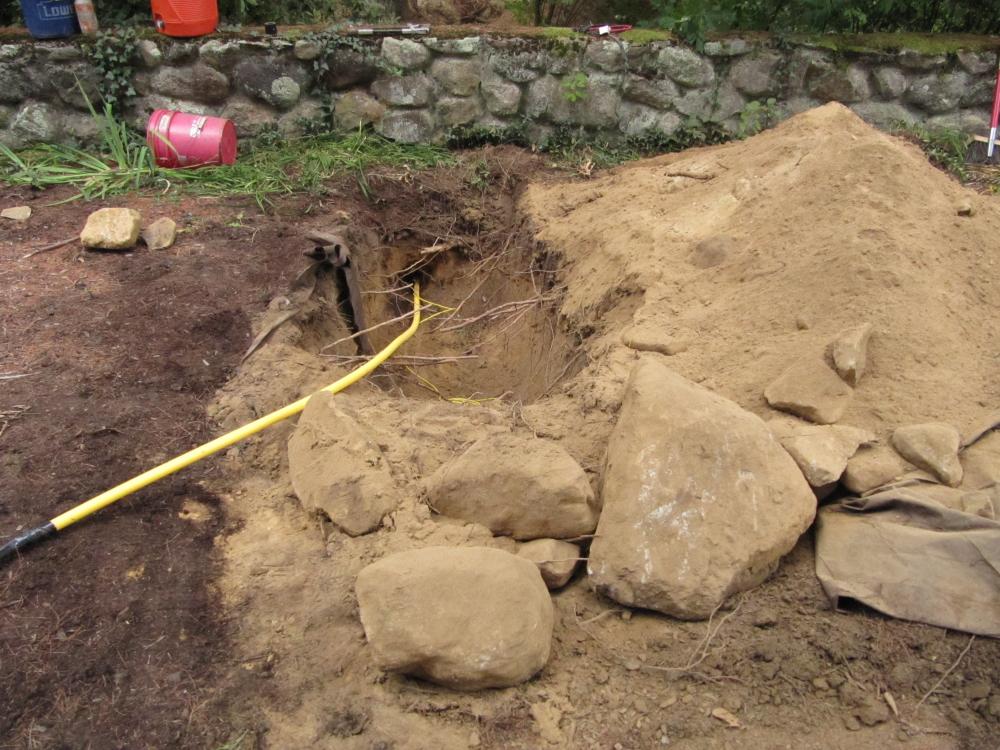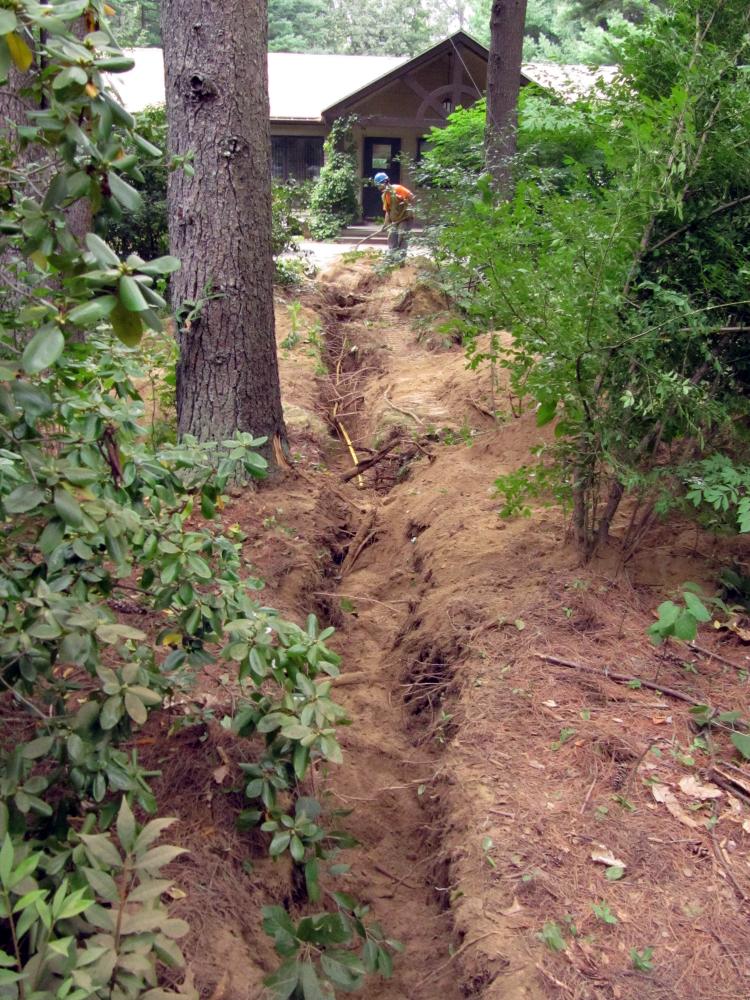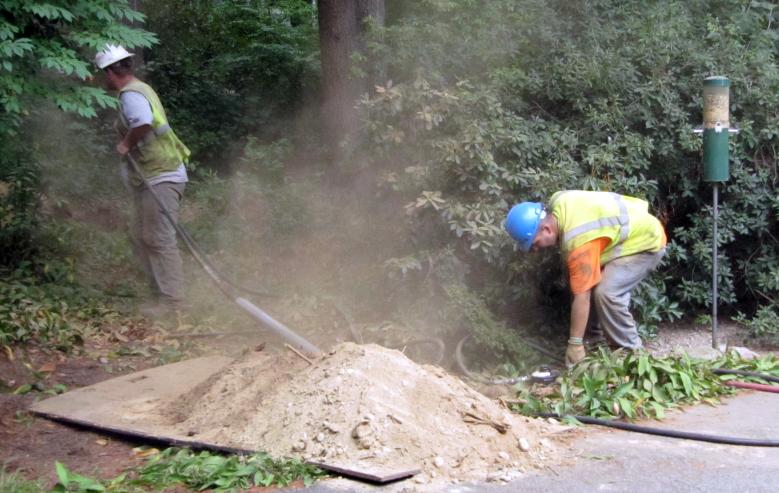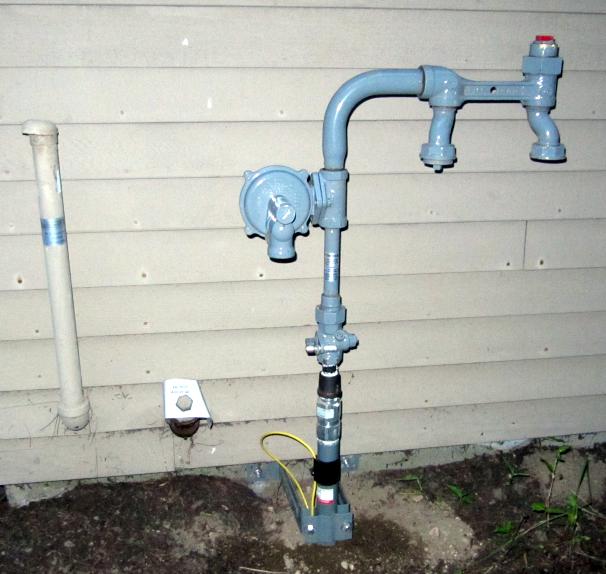 I don't like natural gas. I have memories of it from when I was a small child back in Brooklyn New York. When I was young enough to remember very little else, I recall my parents trying to decide whether they smelled leaking gas. I remember falling asleep with difficulty, worried that I would be poisoned in the night, and never wake up. Apparently, fear of being poisoned is a theme in my life. Recall my very early blog entry, The Poison Apple (bis). Still a child, but a bit later in life, I seem to recall staying in a borrowed apartment in Los Angeles, and hearing the same worries about an odor of gas (although this memory is rather hazy). I think our trip to Los Angeles was in 1957, when I would have been 15 years old. When we bought our house here in Wayland in 1972, we were contacted by the gas company. They told us that if we installed three gas appliances in our house (for example, a gas furnace, a gas dryer, and a gas range), they would connect the house up to the gas main running under our street at no charge. But I turned them down. Although I know that cooking on a gas range is considered to be superior to the electric range that we were using (and still use), I didn't want gas in my house. There's one problem with gas leaks that's particular to me. Natural gas is not only poisonous, it's also odorless. Because of this, gas companies add a chemical odorant, butyl mercaptan, to the gas, to give it a strong odor. This allows it to be easily detected if there's any leak. Easily detected by most people, that is. Not by me - I don't have a very good sense of smell. Due to general allergic rhinitis, I don't have good airflow over the smell receptors in my nose. Although I have a reasonably good sense of taste (which does involve smell, but in the back of the mouth), I in fact barely have a sense of smell at all. Thus, unbelievable as it may seem, I smelled nothing peculiar years ago when I let our dog Chester into the house late one evening after he had been sprayed by a skunk. This story was told in my blog entry Chester. The fact that I might not necessarily be able to smell a gas leak makes natural gas a bit more dangerous for me than it might be for others. Although my childhood worries about natural gas were primarily about the risk of being poisoned, here in Massachusetts recently the major problem with natural gas seems to be explosions. Every now and then, at least once every few years, a house blows up. This isn't usually due to a small leak, though. Generally speaking, it occurs when somebody ruptures a high pressure gas line outside a house, often when digging with a backhoe. The high-pressure gas follows the loose soil along the outside of the pipe that enters the home, and fills the house with a very large amount of gas rather quickly. Nevertheless, reading of these explosions in the news gave me one more reason to not want gas in my home. However, things change. The oil we use for heat and hot water has become fabulously expensive. A typical oil delivery fills about three quarters of our 275 gallon tank, and costs over $800 (and we go through quite a few tanks in the course of a winter). At current prices, doing the same job with natural gas costs considerably less, so a gas conversion could have only a two- to three-year payback. Furthermore, due to the amount of natural gas produced by the new technology of hydraulic fracturing ("fracking"), my estimation is that natural gas will be quite a bit cheaper than oil for years to come. When I called my oil company to call off our automatic deliveries and cancel our account, the representative tried to convince me otherwise, but he failed to do so. We'll see if I'm right. Meanwhile, gas leak detectors have become available, making my lack of a good sense of smell less important. Our oil furnace is over 25 years old. Our hot water heater, with a separate burner, is 18 years old, and an identical unit failed catastrophically after six years, flooding the basement. Note 1 But what finally convinced me to do a gas conversion was a desire to install a generator. This will be an automatic "whole house" generator, which will turn itself on in the event of a power failure. Our last lengthy power failure, during hurricane Sandy in October, 2012, lasted several days. We lost the contents of our refrigerator and freezer, and the house became rather uncomfortable. I actually find these events somewhat interesting, a break in the routine. But Margie has very little patience for this sort of thing, and has been pushing for us to get a generator. A generator has another advantage, given that we're trying to travel more and more. An automatic generator can keep the house safe in the event of long power failures even in our absence. It also will see to it that the sump pump in the French drain in our basement could run for a long period of time if necessary. The problem with such a generator is, what should it be fueled by? Gasoline is not a great alternative, because the fuel of a generator can sit unused for quite a few years, and gasoline tends to get stale (it loses some of its volatile components). A better alternative is propane, which keeps for a long time. But we learned that for a large generator, two 100 gallon tanks of propane are generally recommended, and even then, it will only power the house for a few days. After that, you're out of luck until you can get another delivery. The best fuel is natural gas. Since it arrives by pipe, there's no tank to be refilled. The generator is cheaper to install because propane tanks are not necessary, and they're expensive (and also large and ugly). So it was a desire to have a generator that provided the final impetus to finally connect us up to the natural gas pipe that runs down our street. Of course, the offer for a free installation of a connection expired 41 years ago. The gas company will no longer do this for free. When I first asked them about an installation, I asked them about connecting a generator only. They quoted something like $3,500 (I don't remember the exact amount) to dig up the street and run the pipe. That was the full cost of the project, because the user of a generator doesn't purchase very much gas. This is obviously because the gas is used only for a weekly check of the generator, and beyond that only if there's actually a power outage or two in the course of a year. But when I proposed changing my furnace and hot water over to gas heat, the cost of running the pipe dropped to $1,300. In other words, the gas company subsidizes the installation, because they will then sell me a meaningful amount of gas. I'll have 90 days after the installation is completed to install the furnace. Otherwise, they will back-bill me for the full cost of the installation. Of course, we've already arranged with a contractor for the installation, and it's scheduled for about three weeks from today. So an incoming gas line was installed about a week ago, which involved laying a pipe underground from the side of the road up to my house. This required it to cross under my paved driveway. The second phase will be excavation of the street to complete the actual hook up to the gas line. It was supposed to have been done today, but has been postponed, apparently due to weather - they can't hot-patch the cut in the street if it's raining (although in fact the rain stopped shortly after the crews left). Here are some photos of the installation, the first of which shows the yellow plastic high pressure gas pipe tunneling under our stone wall, which runs along the street. A yellow electrical wire runs alongside it, called a "tracer" wire. If the gas company in the future needs to locate the buried pipe, they put a signal on the tracer wire to allow it to be detected. This is because the plastic pipe could not otherwise be detected, unlike a metal pipe, which can be found using a metal detector without the necessity of a tracer wire. The enormous rocks that were pulled out of the hole can be seen in the foreground. The largest of them is probably about half a meter across. This is typical of New England soil.  A backhoe with a narrow shovel was then used to dig a trench across the woods in front of our house. The view below shows the trench from the stone wall end.  The pipe then had to cross our driveway. It's sometimes necessary to also use the backhoe to dig a trench across the driveway, and then repair the damage with fresh asphalt. But in my case, the installers were able to use a device which they called a "gopher" to burrow underneath. It seems to push its way through by vibrating, generating quite a bit of dust in the process. You can see it in the photo being pulled back out of the hole, with the cloud of dust still lingering in the air.  Since this operation was successful, my driveway remained undamaged. This may not continue to be the case, because we want the generator to be on the opposite side of the driveway from the house, and that may eventually require a cut in the pavement. The gopher had also been used to tunnel under the stone wall, and an effort was made to use it to tunnel in the woods between a few short cuts that had been made by the backhoe. The crew essentially made a kind of dotted line of holes, and tried to "gopher" between them. But there were too many large rocks and roots in the woods, so in the end they had to use the backhoe to make the long trench shown two photos above. Here's where the line ends at the front of our house - you can see the house end of the yellow tracer wire. Could the company possibly make this any uglier? Well, yes, wait until the actual gas meter is installed. It will hang from the pipes on the right side. Maybe we can build some sort of box around it to hide it. The piping to the left, used for oil delivery, will be removed when the gas furnace is installed and the oil tank has been taken away.  Added note: subsequent blog entries show further steps in this project. Gas (bis) shows our old heating system before it was demolished, and Demo day shows it being taken apart. Gas (ter) shows the completed heat and hot water system. Of course, if you suddenly stop hearing from me altogether, that may mean I've been poisoned in my sleep, or my house has blown up.
  Note 1: The reason the original water heater failed after only six years was because Wayland water at the time was quite acidic. It turns out that water heater tanks contain zinc coated rods, called "anode rods", whose job is to be sacrificed to electrolytic corrosion. This prevents corrosion of the tank. The trouble is, nobody tells you about these, and lets you know that they need to be periodically pulled out for inspection, and replaced if necessary. I was lulled into a false sense of security by the fact that I had my water heater serviced annually. But in fact, the company doing the servicing only deals with the part of the unit called the "oil burner", the part that actually sprays oil into the combustion chamber for burning. They clean the burner and check its efficiency and otherwise service it, but don't concern themselves with checking the anode rods. Nor do they even bother to tell the homeowner that the anode rods exist and need to be checked. When the original hot water tank was inspected after it had burst, the two anode rods were found to have been completely eaten up by the acidic Wayland water. Once they were gone, electrolytic corrosion had attacked the tank. The replacement tank, one of the same type, also contained anode rods. But after the initial failure, I knew enough to have them pulled out and checked periodically (this involves draining a bit of the water at the top of the tank). In the interim, however, Wayland started treating its water to make it less acidic. Thus the replacement tank has lasted 18 years. The last time I checked, the anode rods looked awful, pitted with corrosion, but with still enough zinc left to protect the tank. Still, after 18 years, I'll be happy to see this tank go. The replacement tank will be stainless steel, with a lifetime guarantee. [return to text]  |